child seat JEEP CHEROKEE 2020 Owner handbook (in English)
[x] Cancel search | Manufacturer: JEEP, Model Year: 2020, Model line: CHEROKEE, Model: JEEP CHEROKEE 2020Pages: 332, PDF Size: 8.87 MB
Page 8 of 332
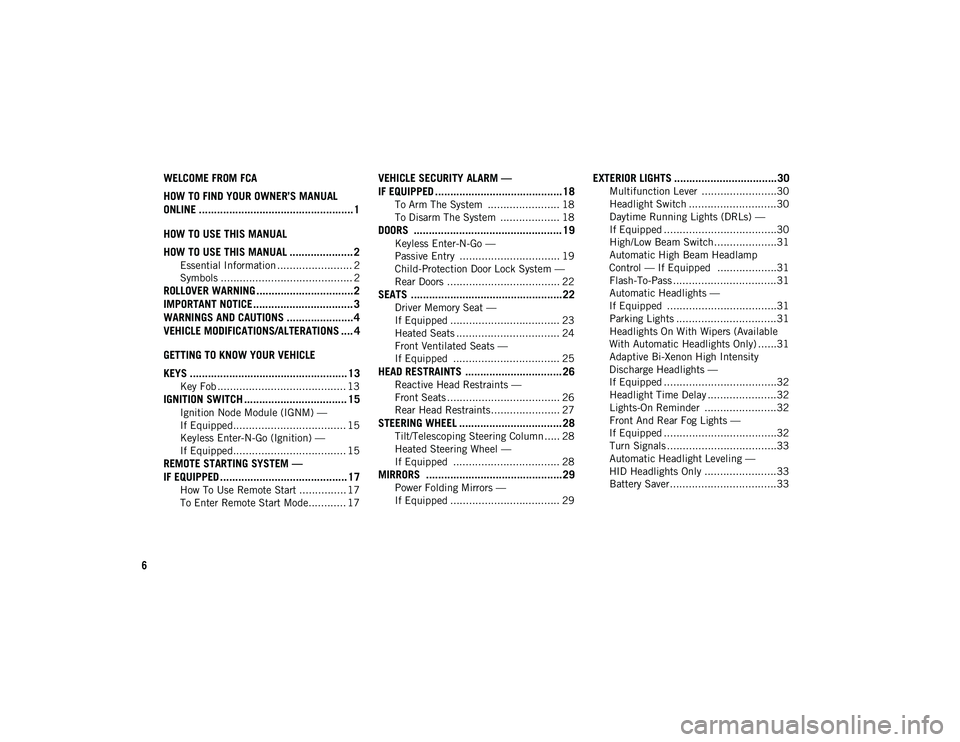
6
WELCOME FROM FCA
HOW TO FIND YOUR OWNER’S MANUAL
ONLINE ................................................... 1
HOW TO USE THIS MANUAL
HOW TO USE THIS MANUAL ..................... 2
Essential Information ........................ 2
Symbols .......................................... 2
ROLLOVER WARNING ................................ 2
IMPORTANT NOTICE ................................. 3
WARNINGS AND CAUTIONS ...................... 4
VEHICLE MODIFICATIONS/ALTERATIONS .... 4
GETTING TO KNOW YOUR VEHICLE
KEYS .................................................... 13
Key Fob ......................................... 13
IGNITION SWITCH .................................. 15
Ignition Node Module (IGNM) —
If Equipped.................................... 15 Keyless Enter-N-Go (Ignition) —
If Equipped.................................... 15
REMOTE STARTING SYSTEM —
IF EQUIPPED .......................................... 17
How To Use Remote Start ............... 17
To Enter Remote Start Mode............ 17
VEHICLE SECURITY ALARM —
IF EQUIPPED ..........................................18
To Arm The System ....................... 18
To Disarm The System ................... 18
DOORS ................................................. 19
Keyless Enter-N-Go —
Passive Entry ................................ 19 Child-Protection Door Lock System —
Rear Doors .................................... 22
SEATS ..................................................22
Driver Memory Seat —
If Equipped ................................... 23 Heated Seats ................................. 24
Front Ventilated Seats —
If Equipped .................................. 25
HEAD RESTRAINTS ................................ 26
Reactive Head Restraints —
Front Seats .................................... 26 Rear Head Restraints...................... 27
STEERING WHEEL .................................. 28
Tilt/Telescoping Steering Column ..... 28
Heated Steering Wheel —
If Equipped .................................. 28
MIRRORS .............................................29
Power Folding Mirrors —
If Equipped ................................... 29
EXTERIOR LIGHTS ..................................30
Multifunction Lever ........................30
Headlight Switch ............................30
Daytime Running Lights (DRLs) —
If Equipped ....................................30 High/Low Beam Switch....................31
Automatic High Beam Headlamp
Control — If Equipped ...................31 Flash-To-Pass .................................31
Automatic Headlights —
If Equipped ...................................31 Parking Lights ................................31
Headlights On With Wipers (Available
With Automatic Headlights Only) ......31 Adaptive Bi-Xenon High Intensity
Discharge Headlights —
If Equipped ....................................32 Headlight Time Delay ......................32
Lights-On Reminder .......................32
Front And Rear Fog Lights —
If Equipped ....................................32 Turn Signals ...................................33
Automatic Headlight Leveling —
HID Headlights Only .......................33 Battery Saver ..................................33
2020_JEEP_CHEROKEE_UG_RHD_UK.book Page 6
Page 10 of 332
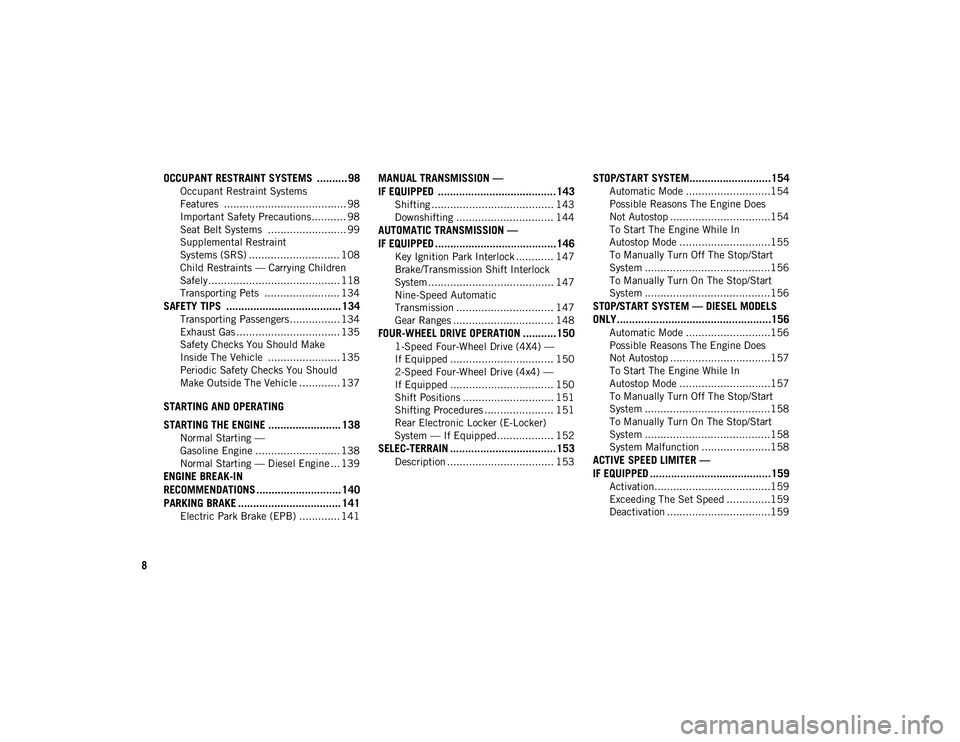
8
OCCUPANT RESTRAINT SYSTEMS .......... 98
Occupant Restraint Systems
Features ....................................... 98 Important Safety Precautions ........... 98
Seat Belt Systems ......................... 99
Supplemental Restraint
Systems (SRS) ............................. 108 Child Restraints — Carrying Children
Safely.......................................... 118 Transporting Pets ........................ 134
SAFETY TIPS ...................................... 134
Transporting Passengers ................ 134
Exhaust Gas ................................. 135
Safety Checks You Should Make
Inside The Vehicle ....................... 135 Periodic Safety Checks You Should
Make Outside The Vehicle ............. 137
STARTING AND OPERATING
STARTING THE ENGINE ........................ 138
Normal Starting —
Gasoline Engine ........................... 138 Normal Starting — Diesel Engine ... 139
ENGINE BREAK-IN
RECOMMENDATIONS ............................ 140PARKING BRAKE .................................. 141
Electric Park Brake (EPB) ............. 141
MANUAL TRANSMISSION —
IF EQUIPPED .......................................143
Shifting ....................................... 143
Downshifting ............................... 144
AUTOMATIC TRANSMISSION —
IF EQUIPPED ........................................146
Key Ignition Park Interlock ............ 147
Brake/Transmission Shift Interlock
System ........................................ 147 Nine-Speed Automatic
Transmission ............................... 147 Gear Ranges ................................ 148
FOUR-WHEEL DRIVE OPERATION ...........150
1-Speed Four-Wheel Drive (4X4) —
If Equipped ................................. 150 2-Speed Four-Wheel Drive (4x4) —
If Equipped ................................. 150 Shift Positions ............................. 151
Shifting Procedures ...................... 151
Rear Electronic Locker (E-Locker)
System — If Equipped.................. 152
SELEC-TERRAIN ...................................153
Description .................................. 153
STOP/START SYSTEM...........................154
Automatic Mode ...........................154
Possible Reasons The Engine Does
Not Autostop ................................154 To Start The Engine While In
Autostop Mode .............................155 To Manually Turn Off The Stop/Start
System ........................................156 To Manually Turn On The Stop/Start
System ........................................156
STOP/START SYSTEM — DIESEL MODELS
ONLY...................................................156
Automatic Mode ...........................156
Possible Reasons The Engine Does
Not Autostop ................................157 To Start The Engine While In
Autostop Mode .............................157 To Manually Turn Off The Stop/Start
System ........................................158 To Manually Turn On The Stop/Start
System ........................................158 System Malfunction ......................158
ACTIVE SPEED LIMITER —
IF EQUIPPED ........................................159
Activation.....................................159
Exceeding The Set Speed ..............159
Deactivation .................................159
2020_JEEP_CHEROKEE_UG_RHD_UK.book Page 8
Page 24 of 332
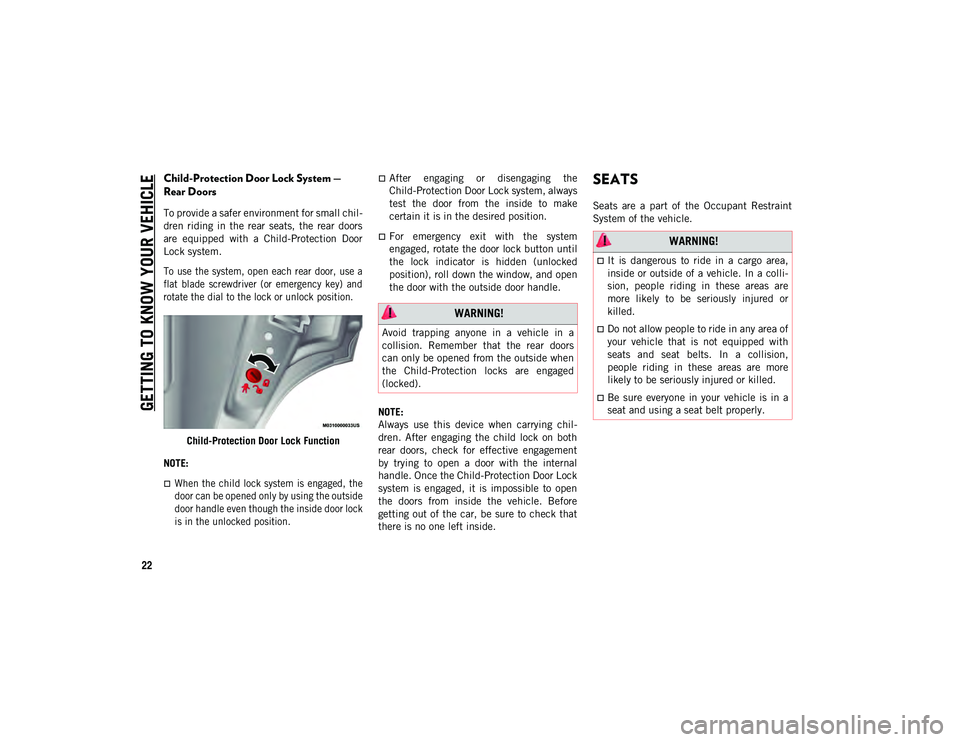
GETTING TO KNOW YOUR VEHICLE
22
Child-Protection Door Lock System —
Rear Doors
To provide a safer environment for small chil-
dren riding in the rear seats, the rear doors
are equipped with a Child-Protection Door
Lock system.
To use the system, open each rear door, use a
flat blade screwdriver (or emergency key) and
rotate the dial to the lock or unlock position.
Child-Protection Door Lock Function
NOTE:
When the child lock system is engaged, the
door can be opened only by using the outside
door handle even though the inside door lock
is in the unlocked position.
After engaging or disengaging the
Child-Protection Door Lock system, always
test the door from the inside to make
certain it is in the desired position.
For emergency exit with the system
engaged, rotate the door lock button until
the lock indicator is hidden (unlocked
position), roll down the window, and open
the door with the outside door handle.
NOTE:
Always use this device when carrying chil -
dren. After engaging the child lock on both
rear doors, check for effective engagement
by trying to open a door with the internal
handle. Once the Child-Protection Door Lock
system is engaged, it is impossible to open
the doors from inside the vehicle. Before
getting out of the car, be sure to check that
there is no one left inside.
SEATS
Seats are a part of the Occupant Restraint
System of the vehicle.
WARNING!
Avoid trapping anyone in a vehicle in a
collision. Remember that the rear doors
can only be opened from the outside when
the Child-Protection locks are engaged
(locked).
WARNING!
It is dangerous to ride in a cargo area,
inside or outside of a vehicle. In a colli -
sion, people riding in these areas are
more likely to be seriously injured or
killed.
Do not allow people to ride in any area of
your vehicle that is not equipped with
seats and seat belts. In a collision,
people riding in these areas are more
likely to be seriously injured or killed.
Be sure everyone in your vehicle is in a
seat and using a seat belt properly.
2020_JEEP_CHEROKEE_UG_RHD_UK.book Page 22
Page 51 of 332
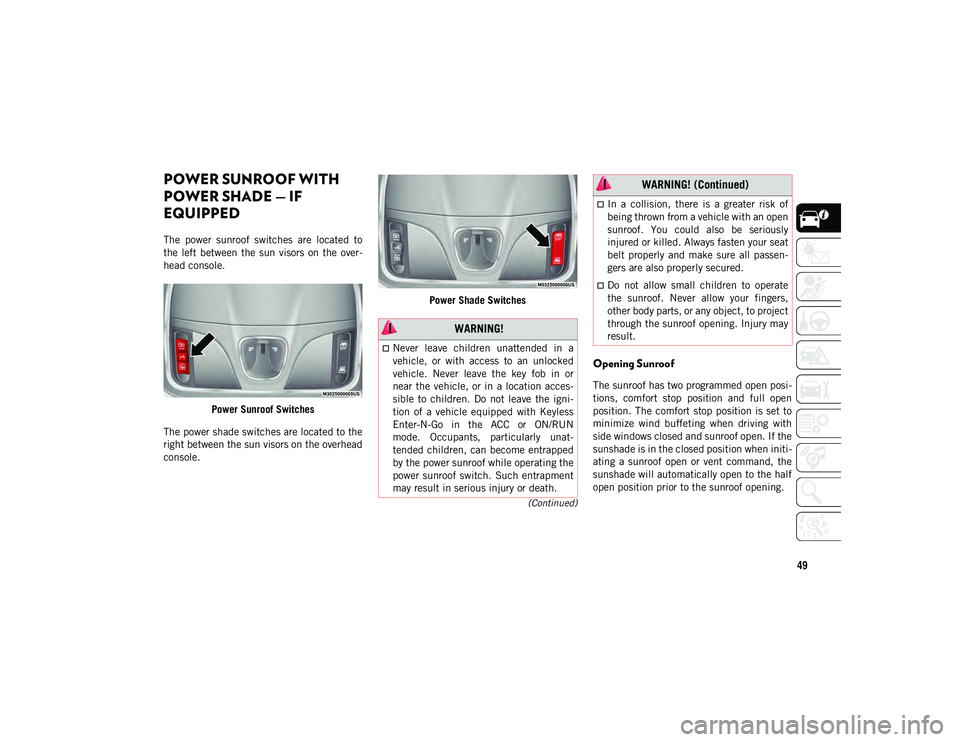
49
(Continued)
POWER SUNROOF WITH
POWER SHADE — IF
EQUIPPED
The power sunroof switches are located to
the left between the sun visors on the over-
head console.
Power Sunroof Switches
The power shade switches are located to the
right between the sun visors on the overhead
console. Power Shade Switches
Opening Sunroof
The sunroof has two programmed open posi
-
tions, comfort stop position and full open
position. The comfort stop position is set to
minimize wind buffeting when driving with
side windows closed and sunroof open. If the
sunshade is in the closed position when initi -
ating a sunroof open or vent command, the
sunshade will automatically open to the half
open position prior to the sunroof opening.
WARNING!
Never leave children unattended in a
vehicle, or with access to an unlocked
vehicle. Never leave the key fob in or
near the vehicle, or in a location acces-
sible to children. Do not leave the igni -
tion of a vehicle equipped with Keyless
Enter-N-Go in the ACC or ON/RUN
mode. Occupants, particularly unat -
tended children, can become entrapped
by the power sunroof while operating the
power sunroof switch. Such entrapment
may result in serious injury or death.
In a collision, there is a greater risk of
being thrown from a vehicle with an open
sunroof. You could also be seriously
injured or killed. Always fasten your seat
belt properly and make sure all passen -
gers are also properly secured.
Do not allow small children to operate
the sunroof. Never allow your fingers,
other body parts, or any object, to project
through the sunroof opening. Injury may
result.
WARNING! (Continued)
2020_JEEP_CHEROKEE_UG_RHD_UK.book Page 49
Page 100 of 332
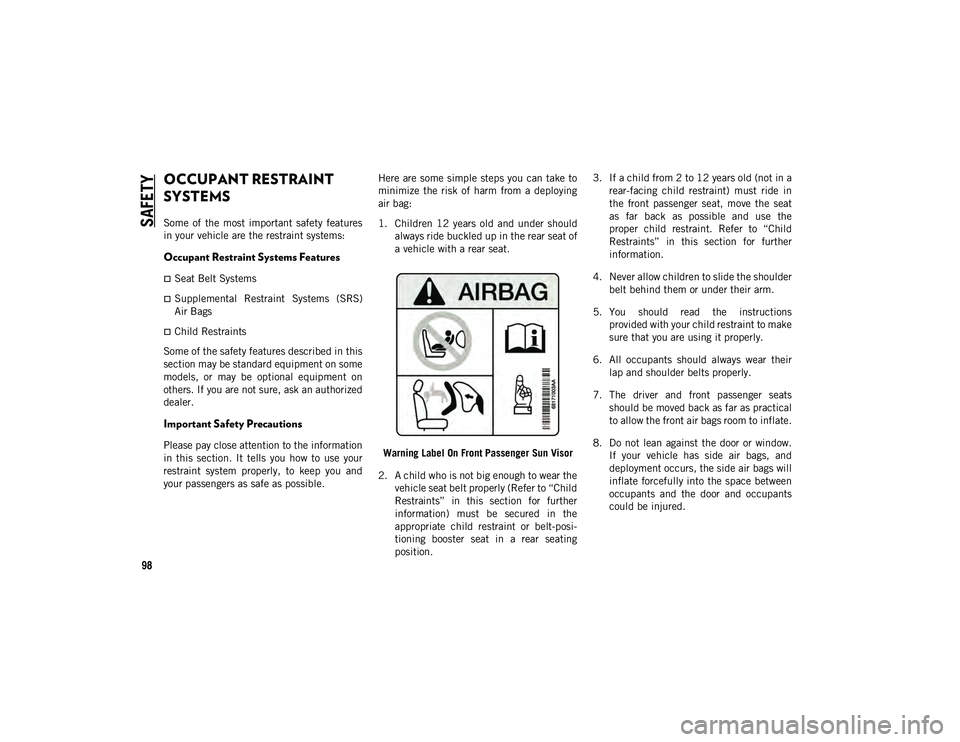
SAFETY
98
OCCUPANT RESTRAINT
SYSTEMS
Some of the most important safety features
in your vehicle are the restraint systems:
Occupant Restraint Systems Features
Seat Belt Systems
Supplemental Restraint Systems (SRS)
Air Bags
Child Restraints
Some of the safety features described in this
section may be standard equipment on some
models, or may be optional equipment on
others. If you are not sure, ask an authorized
dealer.
Important Safety Precautions
Please pay close attention to the information
in this section. It tells you how to use your
restraint system properly, to keep you and
your passengers as safe as possible. Here are some simple steps you can take to
minimize the risk of harm from a deploying
air bag:
1. Children 12 years old and under should
always ride buckled up in the rear seat of
a vehicle with a rear seat.
Warning Label On Front Passenger Sun Visor
2. A child who is not big enough to wear the vehicle seat belt properly (Refer to “Child
Restraints” in this section for further
information) must be secured in the
appropriate child restraint or belt-posi -
tioning booster seat in a rear seating
position. 3. If a child from 2 to 12 years old (not in a
rear-facing child restraint) must ride in
the front passenger seat, move the seat
as far back as possible and use the
proper child restraint. Refer to “Child
Restraints” in this section for further
information.
4. Never allow children to slide the shoulder belt behind them or under their arm.
5. You should read the instructions provided with your child restraint to make
sure that you are using it properly.
6. All occupants should always wear their lap and shoulder belts properly.
7. The driver and front passenger seats should be moved back as far as practical
to allow the front air bags room to inflate.
8. Do not lean against the door or window. If your vehicle has side air bags, and
deployment occurs, the side air bags will
inflate forcefully into the space between
occupants and the door and occupants
could be injured.
2020_JEEP_CHEROKEE_UG_RHD_UK.book Page 98
Page 101 of 332

99
9. If the air bag system in this vehicle needsto be modified to accommodate a
disabled person, refer to the “Customer
Assistance” section for customer service
contact information.Seat Belt Systems
Buckle up even though you are an excellent
driver, even on short trips. Someone on the
road may be a poor driver and could cause a
collision that includes you. This can happen
far away from home or on your own street.
Research has shown that seat belts save
lives, and they can reduce the seriousness of
injuries in a collision. Some of the worst inju -
ries happen when people are thrown from the
vehicle. Seat belts reduce the possibility of
ejection and the risk of injury caused by
striking the inside of the vehicle. Everyone in
a motor vehicle should be belted at all times.
Enhanced Seat Belt Use Reminder System
(BeltAlert)
Front And Rear Seat BeltAlert (If Equipped)
Front Seat BeltAlert
BeltAlert is a feature intended to remind
the driver and outboard front seat passenger
to buckle their seat belts. The BeltAlert
feature is active whenever the ignition switch
is in the START or ON/RUN position. Initial Indication
If the driver is unbuckled when the ignition
switch is first in the START or ON/RUN posi
-
tion a chime will signal for a few seconds. If
the driver or outboard front seat passenger is
unbuckled when the ignition switch is first in
the START or ON/RUN position the respec -
tive Seat Belt Reminder Light will turn solid
red and remain red until the seat belt is
buckled. The respective Seat Belt Reminder
Light will turn solid green once the seat belt
is buckled. After the driver and outboard
front seat passenger have buckled their seat
belts all Seat Belt Reminder Lights will turn
off. The outboard front passenger seat
BeltAlert is not active when the outboard
front passenger seat is unoccupied.
BeltAlert Warning Sequence
The BeltAlert warning sequence is activated
when the vehicle is moving above a specified
vehicle speed range and the driver or
outboard front seat passenger is unbuckled
(the outboard front passenger seat BeltAlert
is not active when the outboard front
passenger seat is unoccupied). The BeltAlert
warning sequence starts by blinking the
respective Seat Belt Reminder Light and
sounding an intermittent chime. Once the
WARNING!
NEVER use a rearward facing child
restraint on a seat protected by an
ACTIVE AIRBAG in front of it, DEATH or
SERIOUS INJURY to the CHILD can
occur.
Never install a rear-facing child restraint
in the front seat of a vehicle. Only use a
rear-facing child restraint in the rear
seat. If the vehicle does not have a rear
seat, do not transport a rear-facing child
restraint in that vehicle.
A deploying passenger front air bag can
cause death or serious injury to a child
12 years or younger, including a child in
a rear-facing child restraint.
2020_JEEP_CHEROKEE_UG_RHD_UK.book Page 99
Page 108 of 332
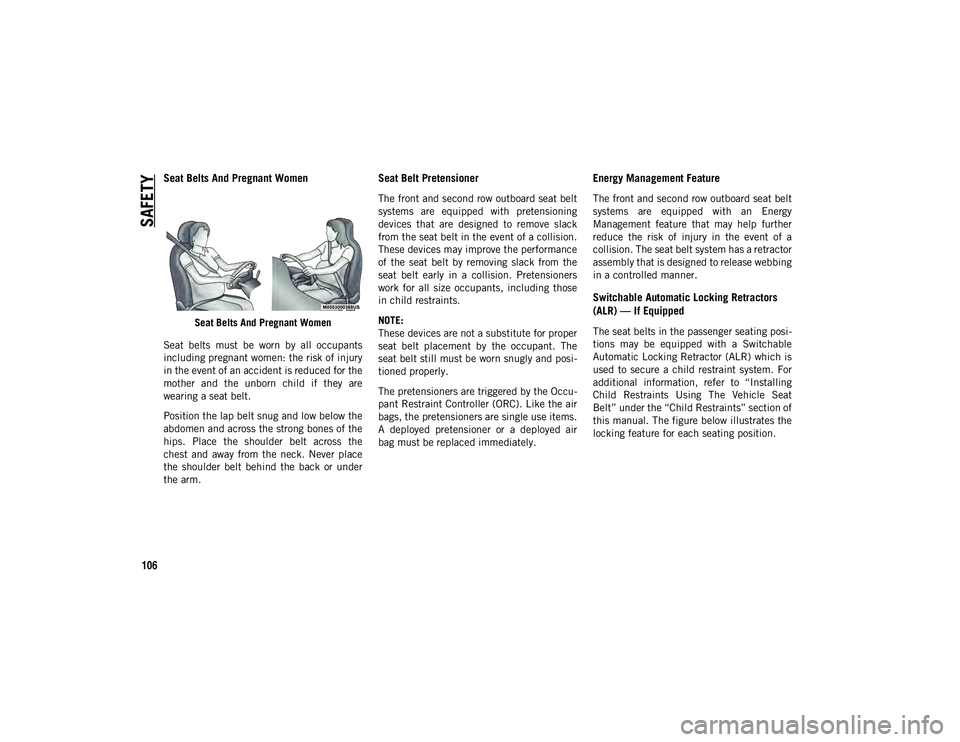
SAFETY
106
Seat Belts And Pregnant Women
Seat Belts And Pregnant Women
Seat belts must be worn by all occupants
including pregnant women: the risk of injury
in the event of an accident is reduced for the
mother and the unborn child if they are
wearing a seat belt.
Position the lap belt snug and low below the
abdomen and across the strong bones of the
hips. Place the shoulder belt across the
chest and away from the neck. Never place
the shoulder belt behind the back or under
the arm.
Seat Belt Pretensioner
The front and second row outboard seat belt
systems are equipped with pretensioning
devices that are designed to remove slack
from the seat belt in the event of a collision.
These devices may improve the performance
of the seat belt by removing slack from the
seat belt early in a collision. Pretensioners
work for all size occupants, including those
in child restraints.
NOTE:
These devices are not a substitute for proper
seat belt placement by the occupant. The
seat belt still must be worn snugly and posi -
tioned properly.
The pretensioners are triggered by the Occu -
pant Restraint Controller (ORC). Like the air
bags, the pretensioners are single use items.
A deployed pretensioner or a deployed air
bag must be replaced immediately.
Energy Management Feature
The front and second row outboard seat belt
systems are equipped with an Energy
Management feature that may help further
reduce the risk of injury in the event of a
collision. The seat belt system has a retractor
assembly that is designed to release webbing
in a controlled manner.
Switchable Automatic Locking Retractors
(ALR) — If Equipped
The seat belts in the passenger seating posi -
tions may be equipped with a Switchable
Automatic Locking Retractor (ALR) which is
used to secure a child restraint system. For
additional information, refer to “Installing
Child Restraints Using The Vehicle Seat
Belt” under the “Child Restraints” section of
this manual. The figure below illustrates the
locking feature for each seating position.
2020_JEEP_CHEROKEE_UG_RHD_UK.book Page 106
Page 109 of 332
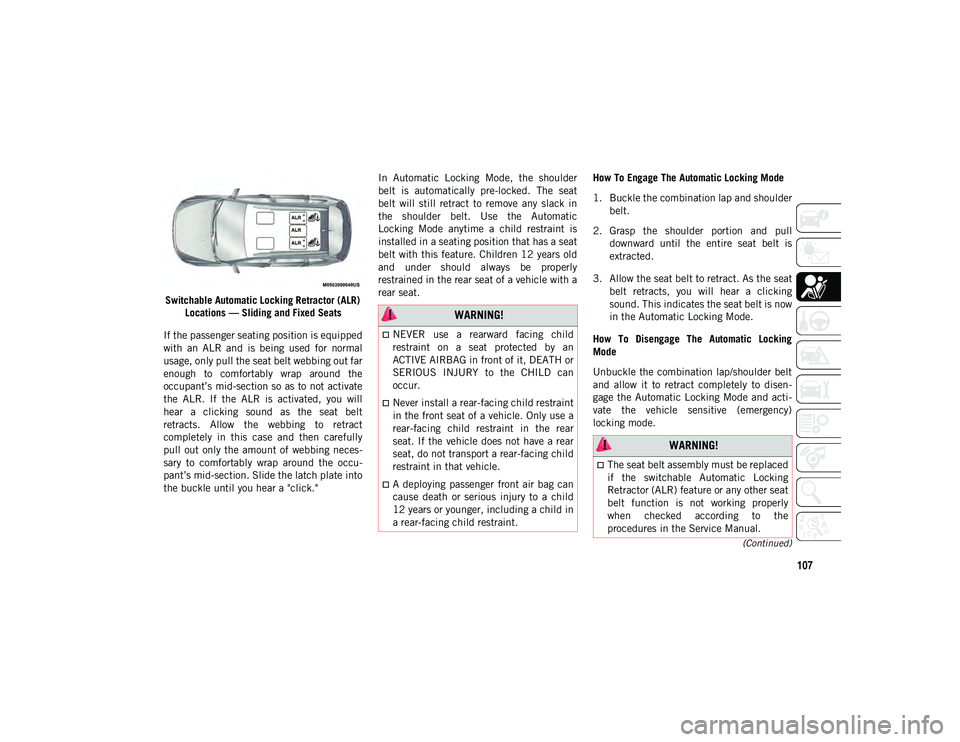
107
(Continued)
Switchable Automatic Locking Retractor (ALR) Locations — Sliding and Fixed Seats
If the passenger seating position is equipped
with an ALR and is being used for normal
usage, only pull the seat belt webbing out far
enough to comfortably wrap around the
occupant’s mid-section so as to not activate
the ALR. If the ALR is activated, you will
hear a clicking sound as the seat belt
retracts. Allow the webbing to retract
completely in this case and then carefully
pull out only the amount of webbing neces -
sary to comfortably wrap around the occu -
pant’s mid-section. Slide the latch plate into
the buckle until you hear a "click." In Automatic Locking Mode, the shoulder
belt is automatically pre-locked. The seat
belt will still retract to remove any slack in
the shoulder belt. Use the Automatic
Locking Mode anytime a child restraint is
installed in a seating position that has a seat
belt with this feature. Children 12 years old
and under should always be properly
restrained in the rear seat of a vehicle with a
rear seat.
How To Engage The Automatic Locking Mode
1. Buckle the combination lap and shoulder
belt.
2. Grasp the shoulder portion and pull downward until the entire seat belt is
extracted.
3. Allow the seat belt to retract. As the seat belt retracts, you will hear a clicking
sound. This indicates the seat belt is now
in the Automatic Locking Mode.
How To Disengage The Automatic Locking
Mode
Unbuckle the combination lap/shoulder belt
and allow it to retract completely to disen -
gage the Automatic Locking Mode and acti -
vate the vehicle sensitive (emergency)
locking mode.
WARNING!
NEVER use a rearward facing child
restraint on a seat protected by an
ACTIVE AIRBAG in front of it, DEATH or
SERIOUS INJURY to the CHILD can
occur.
Never install a rear-facing child restraint
in the front seat of a vehicle. Only use a
rear-facing child restraint in the rear
seat. If the vehicle does not have a rear
seat, do not transport a rear-facing child
restraint in that vehicle.
A deploying passenger front air bag can
cause death or serious injury to a child
12 years or younger, including a child in
a rear-facing child restraint.
WARNING!
The seat belt assembly must be replaced
if the switchable Automatic Locking
Retractor (ALR) feature or any other seat
belt function is not working properly
when checked according to the
procedures in the Service Manual.
2020_JEEP_CHEROKEE_UG_RHD_UK.book Page 107
Page 110 of 332
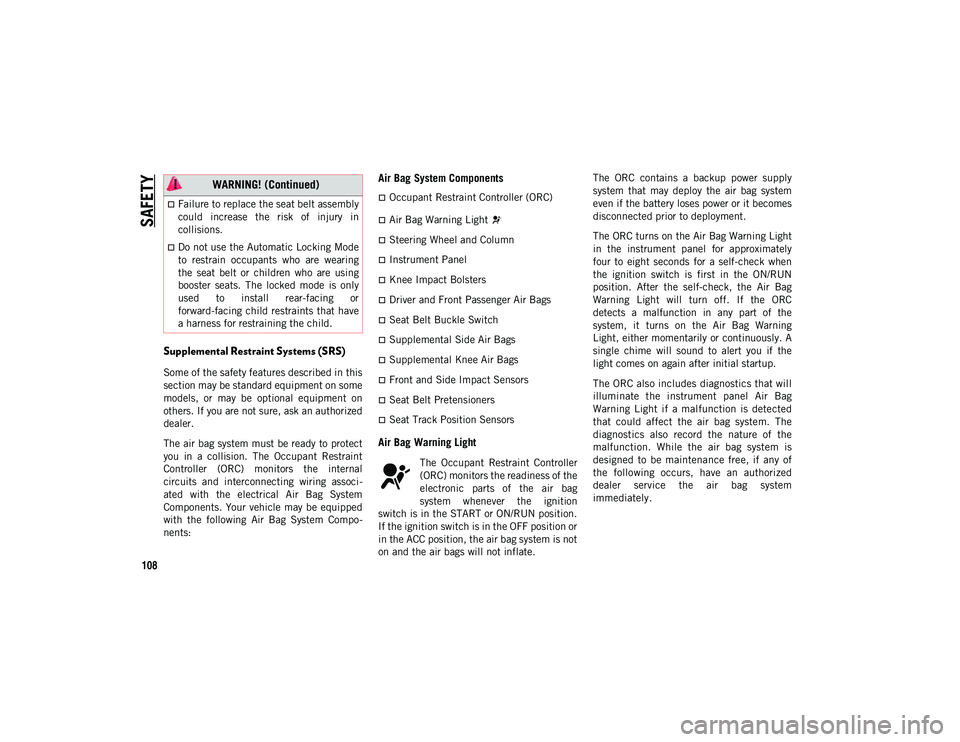
SAFETY
108
Supplemental Restraint Systems (SRS)
Some of the safety features described in this
section may be standard equipment on some
models, or may be optional equipment on
others. If you are not sure, ask an authorized
dealer.
The air bag system must be ready to protect
you in a collision. The Occupant Restraint
Controller (ORC) monitors the internal
circuits and interconnecting wiring associ-
ated with the electrical Air Bag System
Components. Your vehicle may be equipped
with the following Air Bag System Compo -
nents:
Air Bag System Components
Occupant Restraint Controller (ORC)
Air Bag Warning Light
Steering Wheel and Column
Instrument Panel
Knee Impact Bolsters
Driver and Front Passenger Air Bags
Seat Belt Buckle Switch
Supplemental Side Air Bags
Supplemental Knee Air Bags
Front and Side Impact Sensors
Seat Belt Pretensioners
Seat Track Position Sensors
Air Bag Warning Light
The Occupant Restraint Controller
(ORC) monitors the readiness of the
electronic parts of the air bag
system whenever the ignition
switch is in the START or ON/RUN position.
If the ignition switch is in the OFF position or
in the ACC position, the air bag system is not
on and the air bags will not inflate. The ORC contains a backup power supply
system that may deploy the air bag system
even if the battery loses power or it becomes
disconnected prior to deployment.
The ORC turns on the Air Bag Warning Light
in the instrument panel for approximately
four to eight seconds for a self-check when
the ignition switch is first in the ON/RUN
position. After the self-check, the Air Bag
Warning Light will turn off. If the ORC
detects a malfunction in any part of the
system, it turns on the Air Bag Warning
Light, either momentarily or continuously. A
single chime will sound to alert you if the
light comes on again after initial startup.
The ORC also includes diagnostics that will
illuminate the instrument panel Air Bag
Warning Light if a malfunction is detected
that could affect the air bag system. The
diagnostics also record the nature of the
malfunction. While the air bag system is
designed to be maintenance free, if any of
the following occurs, have an authorized
dealer service the air bag system
immediately.
Failure to replace the seat belt assembly
could increase the risk of injury in
collisions.
Do not use the Automatic Locking Mode
to restrain occupants who are wearing
the seat belt or children who are using
booster seats. The locked mode is only
used to install rear-facing or
forward-facing child restraints that have
a harness for restraining the child.
WARNING! (Continued)
2020_JEEP_CHEROKEE_UG_RHD_UK.book Page 108
Page 112 of 332
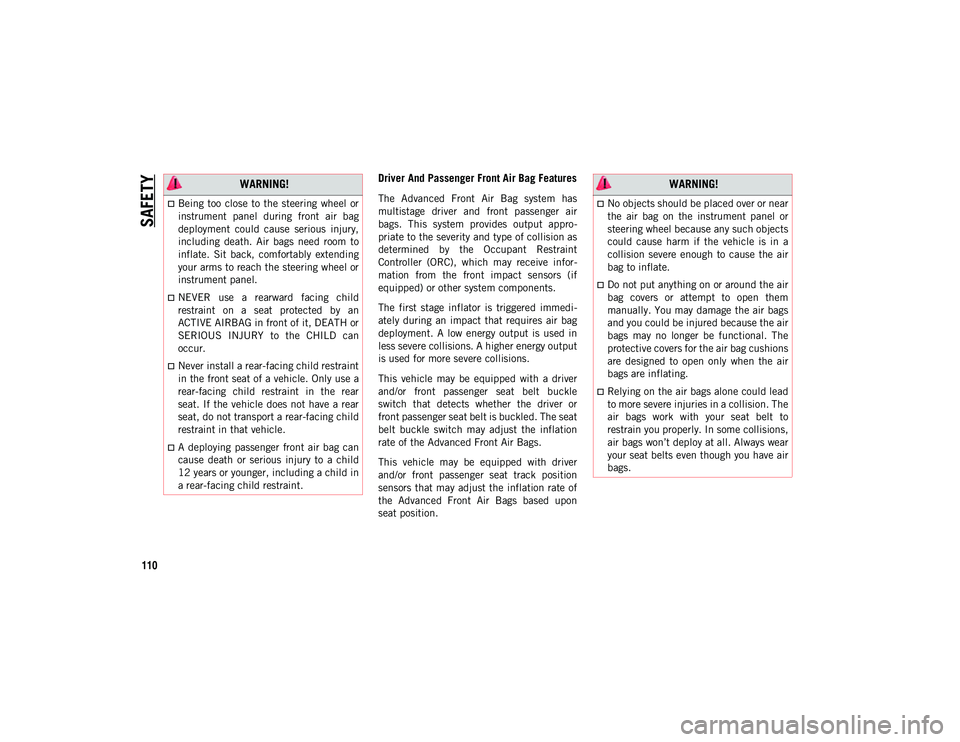
SAFETY
110
Driver And Passenger Front Air Bag Features
The Advanced Front Air Bag system has
multistage driver and front passenger air
bags. This system provides output appro-
priate to the severity and type of collision as
determined by the Occupant Restraint
Controller (ORC), which may receive infor -
mation from the front impact sensors (if
equipped) or other system components.
The first stage inflator is triggered immedi -
ately during an impact that requires air bag
deployment. A low energy output is used in
less severe collisions. A higher energy output
is used for more severe collisions.
This vehicle may be equipped with a driver
and/or front passenger seat belt buckle
switch that detects whether the driver or
front passenger seat belt is buckled. The seat
belt buckle switch may adjust the inflation
rate of the Advanced Front Air Bags.
This vehicle may be equipped with driver
and/or front passenger seat track position
sensors that may adjust the inflation rate of
the Advanced Front Air Bags based upon
seat position.
WARNING!
Being too close to the steering wheel or
instrument panel during front air bag
deployment could cause serious injury,
including death. Air bags need room to
inflate. Sit back, comfortably extending
your arms to reach the steering wheel or
instrument panel.
NEVER use a rearward facing child
restraint on a seat protected by an
ACTIVE AIRBAG in front of it, DEATH or
SERIOUS INJURY to the CHILD can
occur.
Never install a rear-facing child restraint
in the front seat of a vehicle. Only use a
rear-facing child restraint in the rear
seat. If the vehicle does not have a rear
seat, do not transport a rear-facing child
restraint in that vehicle.
A deploying passenger front air bag can
cause death or serious injury to a child
12 years or younger, including a child in
a rear-facing child restraint.
WARNING!
No objects should be placed over or near
the air bag on the instrument panel or
steering wheel because any such objects
could cause harm if the vehicle is in a
collision severe enough to cause the air
bag to inflate.
Do not put anything on or around the air
bag covers or attempt to open them
manually. You may damage the air bags
and you could be injured because the air
bags may no longer be functional. The
protective covers for the air bag cushions
are designed to open only when the air
bags are inflating.
Relying on the air bags alone could lead
to more severe injuries in a collision. The
air bags work with your seat belt to
restrain you properly. In some collisions,
air bags won’t deploy at all. Always wear
your seat belts even though you have air
bags.
2020_JEEP_CHEROKEE_UG_RHD_UK.book Page 110